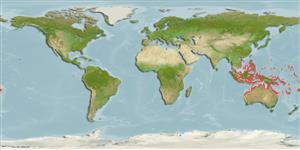Common names from other countries
Environment: milieu / climate zone / depth range / distribution range
Écologie
; profondeur 0 - 20 m (Ref. 348), usually 0 - 15 m (Ref. 75831). Tropical; 23°C - 30°C (Ref. 102835); 19°N - 34°S, 100°E - 174°W (Ref. 106696)
Indo-West Pacific.
Length at first maturity / Taille / Poids / Âge
Maturity: Lm ? range ? - ? cm Max length : 60.0 cm SHL mâle / non sexé; (Ref. 348); common length : 50.0 cm SHL mâle / non sexé; (Ref. 348)
Description synthétique
Morphologie
It is characterized by a low primary and radial sculpture, variable shape, massive umbonal area and smooth white shell.
Locally exploited for meat and shell. This species was previously quite abundant, but has been over collected in many areas. Aquaculture attempts being made (Ref. 348). Found in intertidal areas on corals (Ref. 75831), mainly on reef flats, barrier reefs, fore reefs and atoll lagoons (Ref. 117184). Common in shallow waters wherein juveniles are byssally attached to the tops and sides of coral outcrops. Adults are thought to detach their byssus and settle in clear ocean conditions at 20 m depth (Ref. 101207).
Life cycle and mating behavior
Maturité | Reproduction | Frai | Œufs | Fécondité | Larves
Life cycle: Embryos develop into free-swimming trocophore larvae, succeeded by the bivalve veliger, resembling a miniature clam (Ref. 833).
SAUP Database. 2006. (Ref. 356)
Statut dans la liste rouge de l'IUCN (Ref. 130435)
statut CITES (Ref. 108899)
Not Evaluated
Utilisations par l'homme
Pêcheries: commercial
FAO - Aquaculture: production; | FishSource | Sea Around Us
Outils
Sources Internet
Estimates based on models
Preferred temperature
(Ref.
115969): 24.7 - 29.3, mean 28.6 (based on 2248 cells).
Résilience
Faible, temps minimum de doublement de population : 4,5 à 14 années (K=0.11-0.11; tm=4).
Vulnérabilité
High vulnerability (64 of 100).
Catégorie de prix
Unknown.
